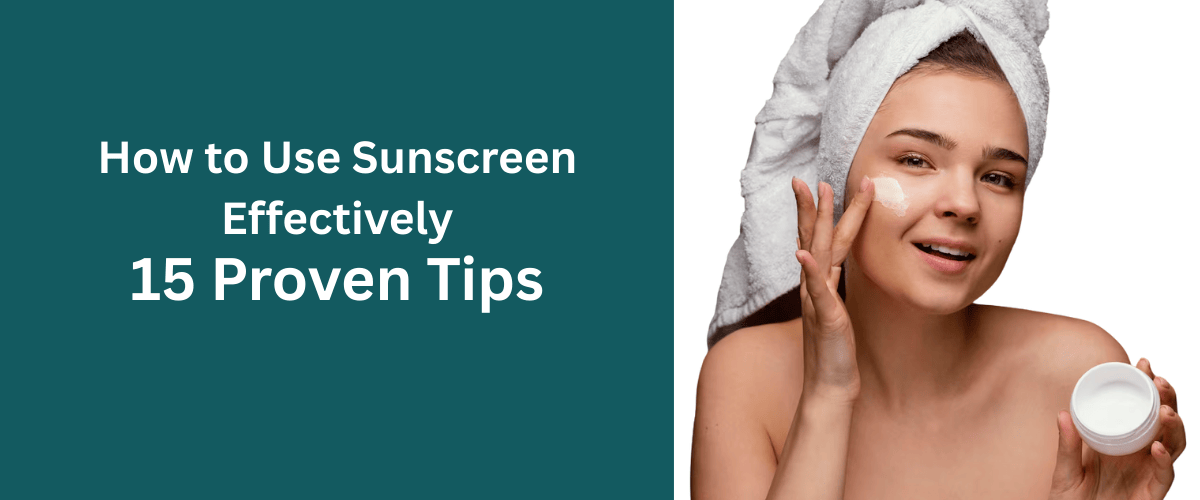Every time you step outside, your skin is exposed to the sun’s harmful UV rays. Over time, this exposure can lead to sunburn, premature aging, and even skin cancer. Using sunscreen effectively is one of the easiest and most essential steps you can take to protect your skin and maintain a youthful, healthy glow. Yet, most people use it incorrectly — or not at all.
Understand How Sunscreen Works
Sunscreen protects the skin by either absorbing or reflecting UV radiation. There are two main types:
- Physical (Mineral) sunscreens contain zinc oxide or titanium dioxide that reflect rays.
- Chemical sunscreens absorb UV rays and convert them into heat.
Both types work well when used properly, but the effectiveness of sunscreen application depends on choosing the right type and using the correct method.
Know the Difference Between UVA and UVB
Understanding UVA and UVB is critical to using sunscreen effectively:
| UV Type | Effect on Skin | Protection Needed |
|---|---|---|
| UVA | Penetrates deep into the skin, causes aging | Look for “Broad-Spectrum” |
| UVB | Causes sunburn and skin cancer | SPF 30+ recommended |
Choose the Right SPF for Your Skin
SPF, or Sun Protection Factor, measures how well a sunscreen protects against UVB rays.
- SPF 15: Blocks ~93%
- SPF 30: Blocks ~97%
- SPF 50: Blocks ~98%
For daily use, SPF 30 or higher is ideal, especially if you're outdoors frequently.
Mineral vs. Chemical Sunscreens
Choosing between mineral vs. chemical sunscreen depends on your skin type and sensitivity:
- Mineral (Physical): Ideal for sensitive skin, works immediately, less irritating
- Chemical: Lightweight, easier to rub in, good for oily or acne-prone skin
Each has pros and cons. The best sunscreen is the one you’ll actually wear.
Read the Label Carefully
When selecting sunscreen, check for:
- Broad-spectrum coverage
- SPF 30 or higher
- Water resistance (40–80 minutes)
- Expiration date
Avoid products with oxybenzone and parabens if you have sensitive skin or are eco-conscious.
Apply the Right Amount of Sunscreen
Most people apply less than half the recommended amount. Use the “Two-Finger Rule”: squeeze a line of sunscreen along your index and middle fingers for each body part.
- Face/Neck: ½ teaspoon
- Arms/Legs: 1 teaspoon each
Torso: 1 teaspoon each for front and back
Timing Matters: When to Apply Sunscreen
Apply sunscreen at least 15-30 minutes before sun exposure. This allows chemical sunscreens to activate and ensures full coverage.
If you're in a rush, mineral sunscreens work instantly but still need even application.
Don’t Skip These Easy-to-Miss Areas
Frequently missed areas include:
- Ears
- Hairline and scalp (for thinning or bald heads)
- Eyelids (use mineral-based)
- Lips (use SPF lip balm)
- Tops of feet
- Backs of hands
These spots are just as prone to damage as the rest of your body.
How Often to Reapply Sunscreen
Even the best sunscreen wears off.
- Reapply every 2 hours
- Immediately after swimming, sweating, or towel-drying
- Use spray sunscreens only as a top-up, not a base layer
Set a reminder if needed. Your skin will thank you.
Sunscreen for Different Skin Types
Different skin types need tailored sunscreen:
Skin Type
Best Sunscreen Type
Oily/Acne-Prone
Gel-based, oil-free, non-comedogenic
Dry
Cream-based, moisturizing
Sensitive
Mineral-based, fragrance-free
Darker Skin
Sheer formulas that avoid white cast
Everyone needs sunscreen — no matter the skin tone.
unscreen Myths You Should Stop Believing
Let’s bust a few common myths:
- Myth: “I don’t need sunscreen on cloudy days.”
Truth: Up to 80% of UV rays penetrate clouds. - Myth: “Dark skin doesn’t burn.”
Truth: Dark skin is less prone but not immune to sun damage.
Myth: “Makeup with SPF is enough.”
Truth: It’s not. Use a dedicated sunscreen underneath.
Water-Resistant Doesn’t Mean Waterproof
The term “waterproof” is banned by the FDA. Instead, look for:
- Water-resistant (40 minutes)
- Very water-resistant (80 minutes)
Always reapply after water exposure. Don’t trust the label blindly.
Sunscreen in Your Daily Skincare Routine
Yes, sunscreen should be a daily part of your skincare, even if you’re indoors:
- Cleanse
- Tone (optional)
- Serum
- Moisturizer
- Sunscreen (last step before makeup)
Blue light from screens also affects your skin — another reason not to skip SPF.
Best Sunscreen Practices for Children and Babies
- Babies under 6 months: Keep out of the sun entirely
- 6 months and older: Use mineral sunscreen (zinc oxide or titanium dioxide)
- Test patch on inner arm before full use
Use hats, long sleeves, and shade for extra protection
The Role of Sunscreen in Anti-Aging
Sunscreen is your best anti-aging product — no contest.
- Prevents fine lines and wrinkles
- Reduces age spots and pigmentation
- Maintains collagen and skin elasticity
Start young, apply daily, and your future self will thank you.
- Prevents fine lines and wrinkles
Frequently Asked Questions (FAQs)
1. Can I skip sunscreen if my foundation has SPF?
No. Foundation with SPF is not applied evenly or thickly enough to protect your skin.
2. Does sunscreen prevent tanning?
Yes, sunscreen reduces tanning by blocking UV rays. However, no sunscreen is 100% effective.
3. Should I wear sunscreen indoors?
Yes, especially near windows or when exposed to screen light for long periods.
4. Is sunscreen safe for daily use?
Absolutely. It’s recommended by dermatologists and safe for all skin types.
5. How long does sunscreen last on the skin?
Most formulas last 2 hours; always reapply after swimming or sweating.
6. Can sunscreen cause breakouts?
Some can. Choose non-comedogenic formulas for acne-prone skin.


